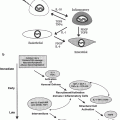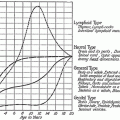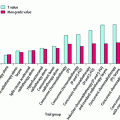Treatment related costs
No recurrence and no complication n = 7
No recurrence but with complication n = 27
Recurrence but no complication n = 6
Recurrence and complication n = 26
RT only
$11,662
$21,770
$37,577
$61,804
$92,050
Induction chemotherapy and radiation
$17,439
$36,045
$43,958
$38,453
$65,208
Concurrent chemoradiation
$12,433
n/a
$58,224
$42,581
$50,576
4.3 Anemia/Neutropenic-Related Costs
Anemia secondary to anti-neoplastic treatment including radiotherapy can adversely affect treatment efficacy as well as decrease a patient’s quality of life. Treatment of the anemia includes red blood cell (RBC) transfusions and use of growth factors such as epoetin. Epoetin beta with concomitant IV iron in anemic patients with lymphoproliferative malignancies not receiving chemotherapy resulted in better outcomes at lower cost compared to epoetin beta without iron (Hedenus et al. 2008). RBC transfusion in an oncology unit was studied in 118 patients in Norway. The annual cost of transfusions was calculated at Euro 1,069 (Norum and Moen 2008). Anemia treatment costs, erythropoietin versus blood transfusion, were analyzed in 12 patients with cervical cancer. Treatment was given either before or during the cancer therapy. Average transfusion-related costs were $990, compared to the projected erythropoietin-related costs of $3,869 (Kavanagh et al. 2001).
The impact of anemia and its treatment on employee disability and medical costs was evaluated in patients receiving chemotherapy within 6 months of cancer diagnosis. The data were also linked to their employer’s short-term disability records. Twenty-five percent of patients had chemotherapy-induced anemia. The presence of anemia and longer length of transfusion therapy were associated with increased expenditures (Berndt et al. 2005). Longer length of erythropoietin alpha use, however, was associated with lower expenditures. The incremental cost of anemia was US $5,538 per month for the first 6 months following cancer diagnosis, 10.8 % of which were costs related to short-term disability leave (Berndt et al. 2005). Costs of neutropenic complications secondary to chemotherapy was evaluated using a US healthcare claims database. Costs of neutropenia-related care were $12,397 higher for neutropenia versus comparison patients (Weycker et al. 2008). Cost of all subsequent neutropenia-related care averaged $6,594 (Weycker et al. 2008). Cost of neutropenic complications in women with metastatic breast cancer treated with chemotherapy was studied in a retrospective cohort design and a US healthcare claims data. Chemotherapy-induced neutropenic complications were experienced in 11% of subjects with cost for inpatient care (88% of patients with complications) averaging $12,869 US Dollars, while the cost for outpatient care was significantly less at $2030 US Dollars (Weycker et al. 2012).
4.4 Targeted Agents
Newer agents targeting specific areas of the cell have gained increasing use in cancer care. They normally have few side effects but some have specific toxicities. Certain targeted agents result in dermatologic toxicity. A recent analysis of 132 patients treated between 2005 and 2008 having a cancer treated with 1 molecularly targeted agent showed patients with a dermatologic toxicity had a median of 3 visits for management of the dermatologic toxicity with a median cost of $1,920 US Dollars. Sorafenib had the highest overall median cost per patient ($2,509 per patient) while imatinib had the lowest overall median cost per patient ($1,263 per patient) (Borovicka et al. 2011). Although small in cost relative to other more costly complications, this is just the start of use of these type of agents and more informations will be forthcoming as their use increases.
Another recent analysis evaluated the economic burden of the use of monoclonal antibodies, bevacizumab, cetuximab, panitumumab, associated with treatment of metastatic colorectal cancer. The highest inpatient cost per event was for treatment of GI perforation ($32,443 US Dollars), followed by fistula ($29,062 US Dollars), and wound-healing complications ($13,240 US Dollars) (Burudpakdee et al. 2012). Inpatient costs to treat hypomagnesemia and skin rash were the lowest with outpatient treatment for skin rash was among the least costly at $185 US Dollars (Burudpakdee et al. 2012).
5 Conclusion
The economic cost of late effects of cancer therapy include not only the cost of treatment the actual complication, such as diarrhea, perforation or neutropenia, but also includes lost productivity of not being able to work and caregiver costs. Unfortunately, the economic consequences of radiotherapy late effects have not been studied extensively to date. With the advent of healthcare reform, studies documenting the economic effect of all cancer therapies, including late effects, need to be performed to decide which treatments provide the most economic use of scarce healthcare dollars.
References
Ahn E, Cho J, Shin DW, Park BW, Ahn SH, Noh DY, Nam SJ, Lee ES, Yun YH (2009) Impact of breast cancer diagnosis and treatment on work-related life and factors affecting them. Breast Cancer Res Treat 116(3):609–616
Stay updated, free articles. Join our Telegram channel

Full access? Get Clinical Tree







